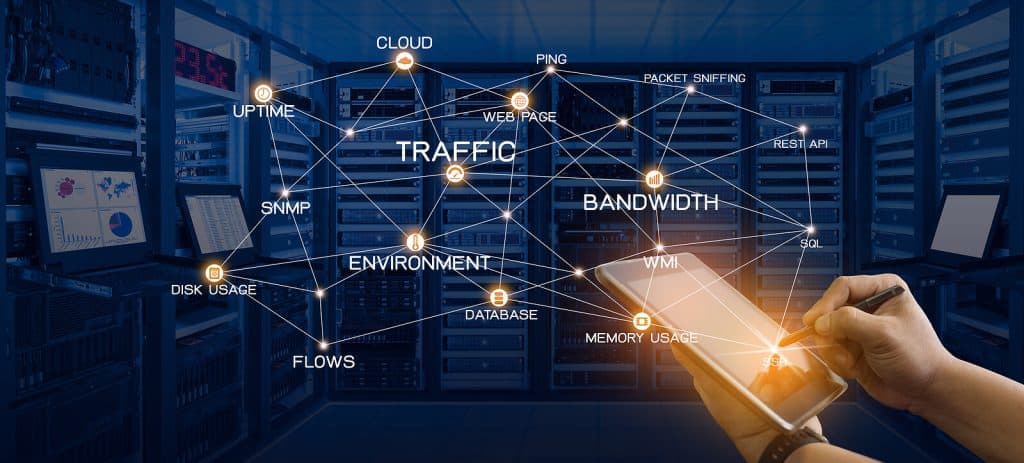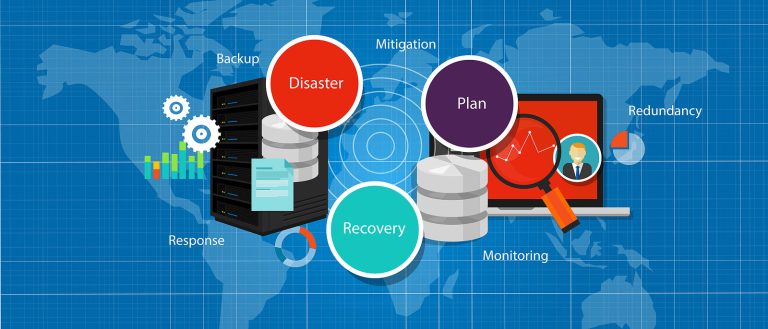Effective network monitoring is essential for ensuring the availability of the IT systems that underpin your business operations. This article will explore the principles of monitoring networks, the type of tools available, how to implement a monitoring system, and more.
Table of Contents
Toggle1. Introduction
a) What Is Network Monitoring?
Network monitoring is a critical IT process that involves the use of various tools and technologies to oversee and manage the operations of network devices and traffic.
At its core, monitoring networks involves continuous scrutiny of a network’s health, ensuring optimal performance of network devices and infrastructures.
b) What is a Network Monitoring System?
A network monitoring system is a set of tools and processes used to oversee and manage a computer network, tracking various aspects of the network’s performance and alerting network administrators to any issues that arise.
c) What is a Network Monitoring Tool?
A network monitoring tool is a software application or a suite of applications designed to monitor and manage a computer network.
d) What Types of Network Devices Should Be Monitored?
Network monitoring software can monitor a wide range of network devices and components, including:
Routers
Switches
Hubs
Bridges
Modems
Gateways
Repeaters
Firewalls
Wireless Access Points (WAPs)
Load Balancers
Virtual Machines (VMs) and Containers
Internet of Things (IoT) Devices
End-User Devices
Environmental Sensors, e.g. temperature, humidity, and power sensors
and more

e) What is the Simple Network Management Protocol?
The Simple Network Management Protocol (SNMP) is one of the most widely deployed network protocols used for managing and monitoring network devices in IP networks.
It is an application-layer protocol that forms part of the Internet Protocol Suite, as defined by the Internet Engineering Task Force (IETF).

2. Who are the Leaders in Technologies for Monitoring Networks?
Leading companies like VMware, Cisco, IBM, and Datadog each offer unique approaches to network monitoring, reflecting their technological expertise. Here are some examples of how these industry giants have shaped the marketplace for monitoring networks:
VMware’s Virtualized Network Focus: VMware specializes in network monitoring for virtualized environments. They offer tools that handle the intricacies of virtual networks, designed to optimize the performance and security of virtual systems.
Cisco’s Integrated Hardware Approach: Cisco integrates network monitoring with its own network hardware products. This synergy between hardware and monitoring software provides a robust solution for physical network infrastructures.
IBM’s Business-Centric Monitoring: IBM aligns network monitoring with business operations, emphasizing the strategic role of network performance in achieving business objectives. Their solutions are tailored to merge IT infrastructure management with broader organizational goals.
Datadog’s Data Analytics Edge: Datadog employs a data-driven approach to network monitoring, focusing on analytics to provide deep insights into network health and performance. This perspective is key to understanding and optimizing network functions in real-time.
3. What are the Types of Network Monitoring Tools?
There are several types of tools for monitoring networks. The optimal choice for each network depends on the network infrastructure, specific organizational needs, network size and complexity, budget constraints, and the desired level of visibility and control.

Here are the primary types of monitoring tools. Each fulfills specific purposes:
SNMP-based Tools
Interact with devices using the Simple Network Management Protocol (SNMP).
Collect device and interface status, traffic statistics, and other metrics.
Examples: most network monitoring tools, including SolarWinds Network Performance Monitor, Nagios, PRTG Network Monitor.
Passive Monitoring Tools
Analyze network traffic without actively injecting probes.
Capture and analyze packets for troubleshooting and network security analysis.
Examples: Wireshark, tcpdump, NetworkMiner.
Active Monitoring Tools
Inject synthetic traffic probes into the network to assess performance.
Measure latency, packet loss, jitter, and other performance metrics.
Examples: ICMP (Internet Control Message Protocol), ping ip addresses, traceroute, iperf, Obkio.
Network Performance Monitoring (NPM) Tools
Focus on measuring and tracking network performance metrics.
Detect and diagnose network bottlenecks, slowdowns, and outages.
Provide real-time and historical performance data of network components for analysis and reporting.
Network Device Monitoring Tools
Monitor the health and status of individual network devices (routers, switches, firewalls, etc.).
Track network component uptime, CPU usage, memory utilization, and other key metrics.
Alert network administrators to potential device failures or network performance issues.
Synthetic Monitoring Tools
Simulate user interactions with applications and services to measure performance and availability from end-user perspectives.
Identify performance issues with network resources that may not be detected by traditional monitoring methods.
Flow-Based Monitoring Tools
Analyze network traffic flows using NetFlow, IPFIX, or sFlow data.
Provide insights into traffic patterns, bandwidth usage, application performance, and security threats.
Distributed Monitoring Tools
Use multiple probes or agents deployed across the entire network to gather data from different locations.
Provide a comprehensive view of network infrastructure performance and health across distributed environments.
Cloud Network Monitoring Tools
Designed for monitoring cloud-based networks and infrastructure.
Integrate with cloud providers’ APIs to collect data and provide visibility into cloud network performance.
Application Performance Monitoring (APM) Tools
Focus on monitoring the performance of applications and services running on the network infrastructure.
Identify application-level issues that may impact user experience.
Often overlap with network monitoring tools, providing a more holistic view of application performance.
4. What are Examples of Software for Monitoring Networks?
A wide variety of software applications for monitoring networks are available, designed to support different aspects of network management and available budgets.
They range from basic monitoring tools to comprehensive network monitoring systems catering to complex infrastructures with thousands of network devices.
To help you decide which is right for your network infrastructure, we will look at a range of available software tools, highlighting their key functionalities and pricing structures.
SolarWinds Network Performance Monitor
SolarWinds offers a comprehensive solution renowned for its scalability and ease of use. Its key features include advanced network troubleshooting, intelligent alerts, and customizable dashboards.
Features: Fault, performance, and availability monitoring; customizable alerts; wireless network monitoring and management.
Pricing: Free trial available. Offers a tiered pricing model based on the scale of deployment. Option to purchase a subscription or a perpetual license.
Nagios XI
Nagios XI provides complete network monitoring with extensive customization options. It is known for its high degree of configurability and comprehensive reporting.
Features: Customizable dashboards, advanced alerting, capacity planning, and reporting.
Pricing: Free trial available. Tiered model based on the scale of deployment. Offers a standard edition plus an Enterprise edition with additional functionality.
Paessler PRTG Network Monitor
PRTG Network Monitor is known for its user-friendly interface and comprehensive coverage of monitoring needs through a sensor-based approach.
Features: Sensor-based monitoring, customizable dashboards, and in-depth reporting.
- Pricing: Free trial available. The tiered model is based on the scale of deployment, 50/100/250/500/1000/1000+ devices. Perpetual license plus renewable maintenance plans.
ManageEngine OpManager
ManageEngine OpManager is a robust real-time monitoring tool offering a broad spectrum of features tailored for medium to large networks.
Features: Real-time monitoring, physical and virtual server monitoring, and bandwidth analysis.
Pricing: Free trial available. Tiered pricing model with 3 levels, standard (10 devices), Professional (10 devices with additional functionality), Enterprise (250 devices)
Wireshark
Wireshark is an open-source network protocol analyzer that allows users to see what’s happening on their network at a microscopic level.
Features: Deep inspection of hundreds of protocols, live capture, and offline analysis.
Pricing: Free and open-source.
5. How Can Network Monitoring Systems Improve Security?
Maintaining the security of IT systems is crucial for every organization. Networks are a vulnerable point in the defense against attack. Monitoring not only supports network security but also the security of the wider computer network.

Using continuous surveillance of network traffic, monitoring systems can detect traffic anomalies that could indicate cyber threats, including:
hacking attempts
denial of service attacks
malware infiltration
unauthorized data breaches
and more.
By setting up alerts for unusual activities and patterns, network administrators can quickly respond to and mitigate these threats.
Monitoring networks can also help to maintain compliance with various cybersecurity protocols, ensuring that an organization’s network aligns with established security standards.
This dual role of maintaining operational integrity and safeguarding against cyber threats makes network monitoring an indispensable tool in the cybersecurity arsenal.
6. How Network Monitoring Supports Business Continuity
In today’s IT-reliant businesses, even a minor network interruption or performance degradation can soon lead to significant disruption of business operations, with consequential financial loss and damaged customer trust.

Monitoring networks can proactively identify and alert network issues, minimize downtime, and safeguard against lengthy and costly outages.
It also supports planning the capacity of network resources and managing network traffic, ensuring that network resources are efficiently utilized to support business needs without overloading the system.
Furthermore, it plays a vital role in compliance and risk management, as network failures can have legal and regulatory implications.
Overall, a well-implemented network monitoring strategy is fundamental in maintaining the resilience and continuity of business operations in the digital era.
Hence a well-designed and implemented network monitoring strategy is not just a technical necessity but also an imperative for business continuity.
7. Tips For Implementation Strategies
Implementing effective network monitoring goes beyond choosing the right tools; it also requires strategic integration into the broader IT management framework.

My top tips for implementation strategies include:
Customization
Adapting solutions to specific organizational needs by identifying unique network configurations, user requirements, and business goals.
This process includes configuring alerts, reports, and dashboards to align with specific operational priorities.
Integration
This strategy focuses on integrating tools for monitoring networks with existing IT infrastructure tools, such as ones for management systems, databases, applications, and other devices, providing unified operations and data coherence.
Scalability
Ensuring that the monitoring system can grow in tandem with the business involves planning for future expansion, choosing scalable tools, and periodically reassessing network capacity requirements.
Proactive Monitoring
Transitioning to proactive monitoring means implementing tools and practices that predict and prevent network issues before they occur, such as anomaly detection, bandwidth monitoring, and automated responses.
Training and Support
Investing in training ensures network administrators are proficient in using monitoring tools and interpreting data. Ongoing support and education keep the team updated on best practices and new features.
8. Benefits of Network Monitoring
Network monitoring systems offer several benefits for maintaining a robust and efficient IT infrastructure:
Improved Network Performance: Continuous monitoring helps identify and resolve performance issues promptly, ensuring optimal network operation.
Proactive Issue Resolution: Detecting potential problems early allows for proactive intervention, reducing downtime and maintaining business continuity.
Enhanced Security: Monitoring aids in identifying security breaches or vulnerabilities, providing an extra layer of protection against cyber threats.
Cost Efficiency: By preventing major network failures, network monitoring can lead to significant cost savings over time.
Data-Driven Decision Making: The insights gained from monitoring enable informed decisions about network upgrades or expansions.
9. How to Choose a Network Monitoring Solution

Selecting the right network monitoring solution for your organization is a critical decision, as it can impact the efficiency and reliability of your organization’s network.
Here are some considerations to guide you in making the right choice:
Network Size and Complexity: Understand the scale and intricacy of your network. Larger, more complex networks will require a solution with advanced features that can handle multiple device types and intricate architectures. Conversely, smaller networks might benefit from a more streamlined and less resource-intensive monitoring system.
Device and Protocol Compatibility: Ensure the solution for monitoring networks is fully compatible with all the devices in your network map, including routers, switches, windows servers, web servers, other network elements, and infrastructure devices. It should also support various communication protocols to effectively monitor and manage your network components.
Budget Considerations: Evaluate the total cost of ownership, which includes the initial purchase price, as well as any ongoing costs related to updates, maintenance, and support. A balanced approach between cost and functionality ensures you don’t overextend your budget while still acquiring a robust monitoring solution.
User Expertise and Manageability: Consider the skill level of your IT team. The solution should match their expertise to avoid a steep learning curve. If the system is overly complex, factor in the cost and time required for additional training and possible hiring of specialized personnel.
Scalability and Future-Proofing: Choose a solution that not only meets your current needs but also anticipates future network growth. Ensure the tool can scale up as your network expands, accommodating new devices and technologies without necessitating a complete system overhaul.
Integration Capability: The network monitoring tool should integrate smoothly with your existing IT infrastructure. This includes compatibility with other management tools, databases, and applications. Effective integration enhances overall system efficiency and reduces the likelihood of conflicts or redundancies.
Support and Training: Investigate the level of support and training the vendor provides. Comprehensive customer service, including timely technical support, software updates, and training resources, can significantly reduce the total strain on your IT staff and streamline the solution’s implementation and ongoing management.
Feature Set and Customization: Examine the specific features offered by the solution, such as real-time monitoring, alerting, reporting capabilities, and diagnostic tools. Customization options are also important, allowing you to tailor the tool to fit your particular network environment and monitoring needs.
Security and Compliance: Ensure that the network monitoring solution adheres to industry standards and regulatory requirements, especially if you operate in a sensitive or highly regulated sector. The tool should help in maintaining security and compliance across your network.
10. Challenges and Solutions in Network Monitoring
Despite the maturity of network monitoring systems, you can still encounter challenges that need solutions.
This is particularly the case for managing complex network infrastructures, requiring a deep understanding of the network’s composition and behavior and the capabilities of the network monitor.
Security threats are another significant challenge, as networks are increasingly targeted by sophisticated cyber-attacks.
Ensuring consistent network performance is also critical, especially in an era where downtime can have substantial business impacts. The solutions include:
Adoption of Advanced Monitoring Tools
State-of-the-art advanced network monitoring software can provide detailed insights into the entire network.
The capabilities of advanced tools include:
real-time analytics
automated network mapping
collection of performance data
logging and tracking network performance problems
testing network connections
support for multiple network protocols
bandwidth monitoring
windows management instrumentation
data packet analysis
automated alerts
predictive maintenance of network elements
the ability to automatically discover monitored devices
and more
Continuous Threat Monitoring
Establishing a robust security protocol that includes constant surveillance for unusual network activities, implementing firewalls, intrusion detection systems, and regular security audits to preemptively identify and mitigate potential threats.
Regular Network Assessments
Scheduling frequent and thorough assessments of the network’s health to detect anomalies, assess traffic patterns, and ensure compliance with the latest standards. This includes stress testing and performance benchmarking.
Best Practices in Network Management
Creating and adhering to a set of best practices such as regular updates and patches, consistent network policy enforcement, and efficient resource allocation to ensure optimal network performance.
Employee Training and Awareness
Conducting regular training sessions for IT staff to keep them informed about the latest network technologies, threats, and best practices.
Encouraging a culture of security awareness among all employees can also significantly reduce risk.
11. Future Trends in Network Monitoring
As monitoring evolves, the integration of cutting-edge technologies like AI and Machine Learning is set to redefine its landscape.

These advancements promise not only to enhance efficiency but also to revolutionize how networks are managed and maintained.
Artificial Intelligence (AI) in Network Monitoring
AI’s capability to process vast amounts of data will enable rapid and automatic network decision-making and anomaly detection. This leads to quicker resolution of network issues, enhancing overall network efficiency and security.
The introduction of AI has already started to transform network monitoring work, introducing advanced automation and intelligent analysis.
Integrating AI with machine learning enables predictive analysis and automated issue resolution, fixing problems before they affect network availability and performance.
Machine Learning in Network Monitoring
Machine Learning (ML) will refine it further by learning from past network behaviors. It helps in predictive maintenance, foreseeing potential network failures before they occur.
ML algorithms can adapt over time, offering increasingly accurate insights into network performance and assisting in resource allocation and traffic prediction for optimized network management.
12. Conclusion
Network monitoring is an essential component of modern IT infrastructure. From ensuring network security to optimizing network performance, it plays a vital role in the smooth operation of business networks.




